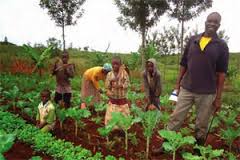Exploring the Distinctions Between Commercial Farming and Subsistence Farming Practices
The duality between commercial and subsistence farming techniques is noted by differing goals, operational scales, and resource utilization, each with profound effects for both the atmosphere and society. On the other hand, subsistence farming highlights self-sufficiency, leveraging standard methods to sustain household requirements while nurturing neighborhood bonds and social heritage.
Economic Objectives
Financial purposes in farming techniques often determine the techniques and range of procedures. In commercial farming, the primary economic objective is to maximize profit. This requires a focus on performance and efficiency, achieved through innovative technologies, high-yield crop varieties, and considerable use of pesticides and fertilizers. Farmers in this design are driven by market demands, aiming to generate huge amounts of products for sale in global and nationwide markets. The emphasis is on accomplishing economic situations of scale, ensuring that the cost each output is minimized, thereby boosting success.
In comparison, subsistence farming is mainly oriented towards satisfying the prompt needs of the farmer's household, with surplus manufacturing being minimal - commercial farming vs subsistence farming. While industrial farming is profit-driven, subsistence farming is focused around sustainability and strength, showing an essentially different set of financial imperatives.

Scale of Operations
The distinction in between industrial and subsistence farming becomes especially obvious when thinking about the scale of procedures. The range of business farming allows for economic situations of scale, resulting in lowered costs per system through mass manufacturing, increased effectiveness, and the capacity to spend in technical developments.
In raw contrast, subsistence farming is generally small, concentrating on producing simply enough food to meet the prompt needs of the farmer's family or local area. The acreage involved in subsistence farming is usually limited, with much less accessibility to contemporary technology or mechanization. This smaller range of procedures reflects a reliance on typical farming strategies, such as manual work and straightforward devices, resulting in reduced efficiency. Subsistence ranches prioritize sustainability and self-sufficiency over earnings, with any type of surplus generally traded or bartered within regional markets.
Resource Usage
Industrial farming, defined by massive operations, usually uses sophisticated innovations and mechanization to enhance the use of sources such as land, water, and plant foods. Precision agriculture is increasingly taken on in industrial farming, utilizing information analytics and satellite innovation to keep an eye on plant wellness and enhance source application, more improving return and resource performance.
In contrast, subsistence farming operates on a much smaller sized range, mainly to fulfill the instant needs of the farmer's household. Source utilization in subsistence farming is typically restricted by financial restrictions and a reliance on traditional strategies.
Environmental Impact

Conversely, subsistence farming, practiced on a smaller range, usually employs conventional strategies that are more in harmony with the surrounding environment. Crop rotation, intercropping, and natural fertilizing prevail, promoting soil health and lowering the requirement for artificial inputs. While subsistence farming commonly Visit Website has a reduced ecological impact, it is not without difficulties. Over-cultivation and poor land management can lead to soil disintegration and deforestation sometimes.
Social and Cultural Effects
Farming methods are deeply linked with the cultural and social textile of communities, influencing and showing their values, customs, and financial frameworks. In subsistence farming, the focus gets on growing adequate food to meet the instant requirements of the farmer's family members, commonly fostering a strong feeling of area and shared responsibility. Such practices are deeply rooted in neighborhood customs, with expertise gave through generations, thereby protecting cultural heritage and reinforcing common connections.
Conversely, industrial farming is largely driven by market demands and profitability, usually leading to a shift towards monocultures and massive procedures. This method can lead to the erosion of typical farming techniques and social identities, as regional personalizeds and knowledge are replaced by standard, industrial approaches. The focus on effectiveness and revenue can sometimes reduce the social cohesion found in subsistence communities, as economic deals replace community-based exchanges.
The dichotomy between these farming techniques highlights the more comprehensive social implications of farming options. find out this here While subsistence farming sustains social connection and neighborhood connection, industrial farming straightens with globalization and financial growth, often at the price of traditional social frameworks and multiculturalism. commercial farming vs subsistence farming. Stabilizing these facets remains a crucial difficulty for sustainable agricultural growth
Final Thought
The evaluation of business and subsistence farming methods discloses considerable distinctions in purposes, scale, resource use, ecological impact, and social implications. Commercial farming focuses on profit and efficiency through massive operations and advanced modern technologies, commonly YOURURL.com at the price of environmental sustainability. On the other hand, subsistence farming highlights self-sufficiency, making use of local resources and standard approaches, consequently advertising cultural preservation and neighborhood cohesion. These contrasting methods highlight the intricate interaction between financial development and the requirement for ecologically sustainable and socially inclusive farming practices.
The dichotomy in between commercial and subsistence farming practices is marked by differing purposes, functional ranges, and resource application, each with extensive ramifications for both the environment and society. While industrial farming is profit-driven, subsistence farming is focused around sustainability and strength, reflecting a fundamentally various set of economic imperatives.
The distinction in between business and subsistence farming becomes especially apparent when considering the scale of operations. While subsistence farming supports cultural connection and area interdependence, business farming lines up with globalization and economic development, commonly at the expense of traditional social frameworks and social diversity.The assessment of commercial and subsistence farming techniques discloses considerable distinctions in goals, range, resource usage, environmental influence, and social implications.